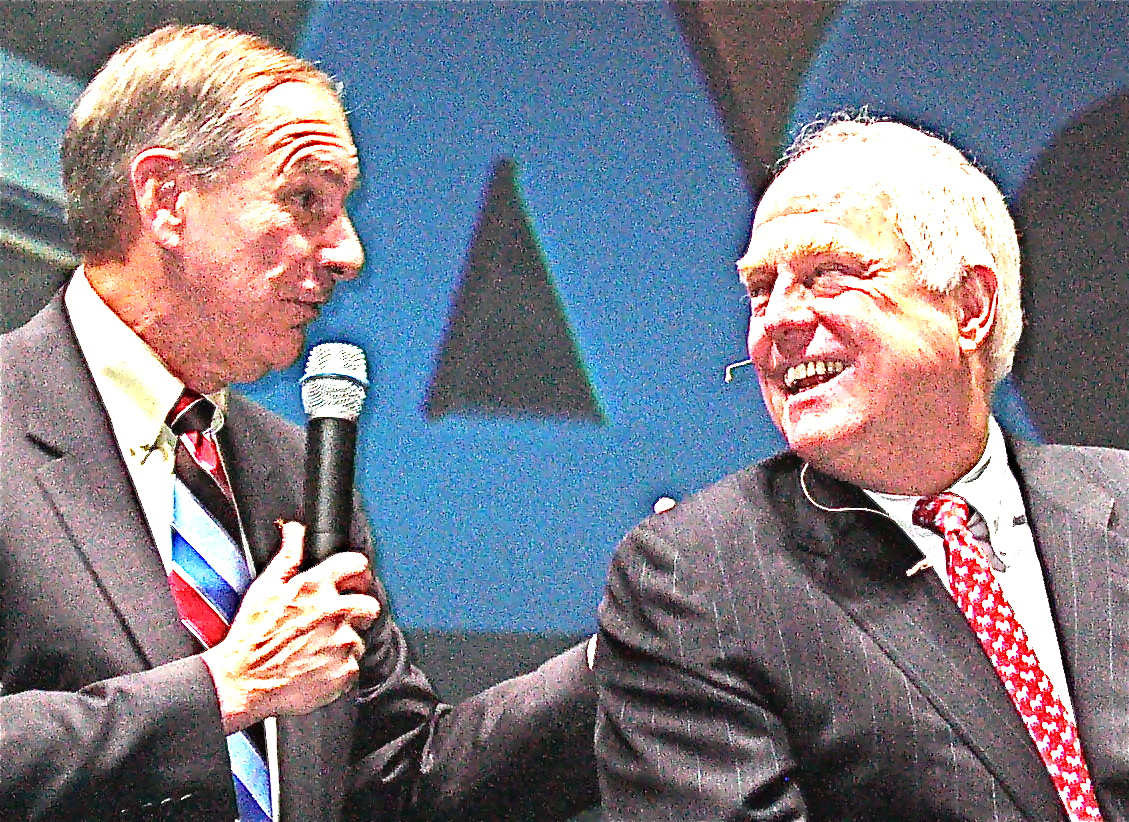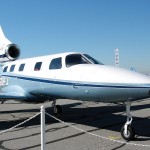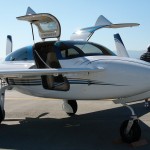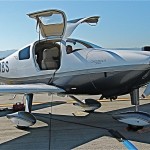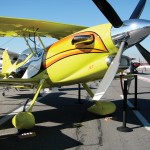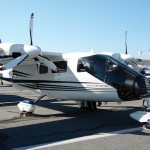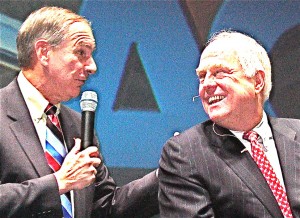
Jim Coyne, president of the National Air Transport Association, was a panelist at the first general session at this year’s AOPA Expo. Here, a comment from AOPA President Phil Boyer gets a rise out of Coyne.
By Jack Elliott
The AOPA Expo 2008 marked the end of an era—the 18-year era of Phil Boyer. Boyer steered the world’s largest pilots’ organization through the most trying years in the history of general aviation and will leave his post at the end of the year with the highest membership ever—414,000, or 75 percent of the pilots in the U.S. This is an incredible achievement.
The changing of the guard was played down here because Boyer kept it low key. However, you could not help but notice the fact that there was a keen awareness among the 9,500 AOPA Expo attendees that the skill, dedication and tremendous energy Boyer gave to the organization greatly increased its stature and effectiveness during his years at the helm.
Taking over for Boyer will be Craig Fuller, an aviator with impressive credentials—more about him later.
One of the most informative functions of the AOPA’s annual conventions is the series of three daily general sessions, where members can get an up-to-the-minute briefing on what’s happening in the world of general aviation, led by high-level panelists and AOPA executives who are making it happen. The three sessions this year were titled “The Day Before Yesterday” (which happened to be Election Day), “Today” and “Tomorrow.”
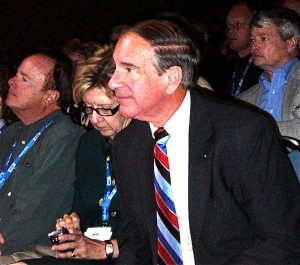
Phil Boyer, listens intently during a video clip of Congressman Peter DeFazio of Oregon, in which the congressman suggested that Boyer should be the next FAA administrator. Boyer responded saying, “No way.”
Panelists for the opening day session included Jane Garvey, former FAA administrator; Steve Alterman, president of the Cargo Airline Association; James Coyne, president of the National Air Transportation Association, and Ken Mead, former Department of Transportation inspector general.
The theme of the opening session, moderated by AOPA Executive Vice President of Government Affairs Andy Cebula, was the impact the election would have on general aviation. Garvey declared that we would have a centrist administration.
“It won’t swing left,” she said. “The future depends on the degree to which aviation comes together.”
Coyne expressed the view that aviation is all about opportunity. “We should not be afraid of our shadows for the rest of our lives,” he said.
Mead expressed the opinion that it is vital to write to your state representative or senator asking them to talk to their transportation representatives. Alterman’s belief is that, “With the economy as it is, nobody cares about aviation.”
During the session, a video was shown in which Congressman Peter DeFazio (D-OR) suggested that Boyer should become the next FAA Administrator. Boyer, sitting in the front row, shook his head and said, “No way.”
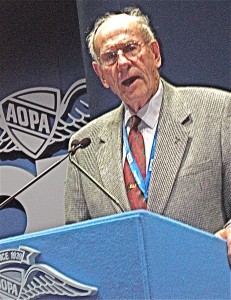
Paul Poberezny, founder of the Experimental Aircraft Association (EAA), addresses the audience of the opening day luncheon.
The opening day luncheon featured 87-year-old Paul Poberezny, founder of the EAA and an icon of the general aviation world. Poberezny recounted the history of that organization from its humble beginnings in his basement, where a small group of aviation enthusiasts gathered to discuss ways they could help each other with homebuilding projects.
Today, as everybody in aviation knows, the EAA AirVenture (affectionately known as “Oshkosh”) is the largest general aviation air show in the world. His talk was a rare journey through grassroots aviation history. At the end, it was both a historic and touching moment to see the two leaders of general aviation standing shoulder-to-shoulder, posing for a battery of photographs to preserve the moment for all time.
In the second general session, dubbed “Today,” Boyer remembered that in 1939 (the year AOPA was founded), the organization had 2,000 members, which was six percent of the nation’s pilot population. Today it has 414,000 members (or 75 percent of U.S. pilots). This growth is particularly remarkable in light of the fact that the pilot population has shrunk from 810,000 in the late 70s to less than 600,000 today.
Boyer also announced that an agreement has been reached with Embry-Riddle Aeronautical University and the University of North Dakota. Now all of their students will automatically become AOPA members.
The most important issue facing general aviation, Boyer declared, is that of user fees. “We got by this year, but the issue will be up for consideration again next year,” he pointed out.
Boyer then turned the session over to what might be considered his “cabinet”—the top executives helping him run the organization. Once again, Cebula stepped in to moderate the discussion. He told members that the user fee issue was closely linked to the NextGen air traffic control system. ADS-B is to be the cornerstone of the new satellite-based system, but Cebula feels that what started out as a good idea has been bogged down by the FAA’s plan for its implementation.
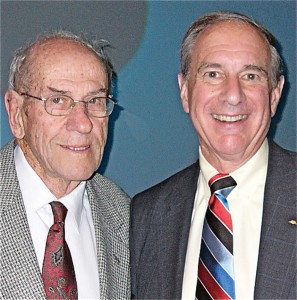
Two of general aviation’s most dedicated and effective leaders—Paul Poberezny (left, founder of EAA) and AOPA President Phil Boyer—stand shoulder-to-shoulder while photographers capture industry history.
Cebula introduced Karen Gebhart, executive vice president of communications for AOPA, who in turn introduced Logan Flood, the most moving and inspirational speaker of the convention.
Flood is a pilot and instructor severely injured in an airplane crash. He was flying right seat with a friend at night in a Baron when icing forced them down in a field while on approach to an airport. Flood was burnt on 85 percent of his body, his face badly scarred. He had 26 operations, and recovery took the best part of a year. During his recovery, he met a nurse and they were married and welcomed a son into their family. Flood’s ambition was to be an airline pilot. He knew the odds were stacked against him, particularly because of his appearance. But eventually he got a job as a first officer with Republic Airways and appeared on stage at the AOPA Expo in his pilot’s uniform.
Gebhart came back to talk about this year’s sweepstakes plane, a Piper Archer restored to mint condition with a glass cockpit. A lucky new or current AOPA member who renews membership will win the aircraft.
The next member of the executive team on the agenda was Greg Sterling, executive vice president of non-dues revenue. Sterling spoke of the AOPA’s products, services, advertising and investments, explaining that all four categories have kept dues at the same level for decades. The revenues from these sources cover three quarters of AOPA’s operating expenses. He pointed out that the Bank of America MasterCard is the largest source of non-dues revenues. Another great value, he said, is the AOPA Legal Plan.
The session wound up with Bruce Landsberg, executive director of the AOPA Air Safety Foundation. Landsberg discussed the foundation’s online safety courses—there have been more than 30,000 course completions, he said.
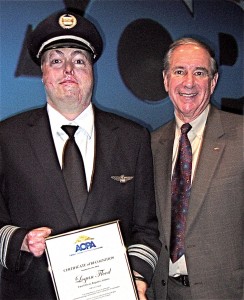
Logan Flood, a pilot who suffered burns on over 85 percent of his body, saw his dream of becoming an airline pilot come true when Republic Airways hired him as a first officer. His touching and inspiring story was told during an AOPA general session.
“We have the largest aviation database in the world.” Landsberg told the capacity audience. “People are afraid of airplanes falling on them, but less people on the ground are killed as a result of airplane accidents than die every year from snake bites.”
He closed by thanking donors for their contributions, which finance the Safety Foundation’s work, and remarked, “We will spend your money more wisely than the government will.”
In the third and final general session, Bill Trimble, chairman of the AOPA board of trustees, had high praise for the outstanding achievements of Phil Boyer during his 18 years at the helm, emphasizing his tireless efforts in fighting user fees. He pointed out that Boyer stayed on an extra year to fight those fees.
Boyer then took center stage to a standing ovation and dropped documents into a flight bag for his successor, Craig Fuller, all of which are part of AOPA’s plans for the future. The documents included AOPA initiatives currently in the works, helping to fill Fuller’s long list of things to do. Prime among these is AOPA’s new Internet Flight Planner, which was previously incompatible with Macintosh computers. The new version, developed in conjunction with Jeppesen, will work on any PC and show TFRs in real time.
Another item symbolically dropped in the bag was the forthcoming partnership agreement with Middle Tennessee State University (similar to the arrangements with Embry-Riddle and the University of North Dakota) in a plan to boost membership.
One key item described the new AOPA Foundation, a tax-free organization designed to raise funds to increase the pilot population, enhance the public image of general aviation, preserve community airports and improve aviation safety. The organization, founded just over a year ago, has raised $26 million toward its “Campaign for GA.” The goal is to raise $56 million.
Fuller, who becomes AOPA’s new president on Jan. 1, 2009, thanked Boyer for filling his bag with so many exciting initiatives. He brings a varied background to his new post, having served in the White House from 1981 to 1989 under Presidents Reagan and George H.W. Bush. Fuller was a business executive and worked for a communications company.
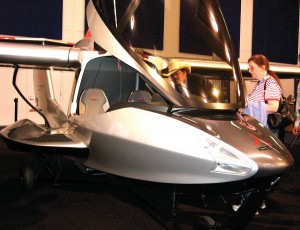
The Icon, a Very Light Sport amphibious aircraft with folding wings, was on display in the convention hall. The aircraft is built by Icon Aircraft of Los Angeles, Calif.
AOPA’s new president learned to fly when he was in high school and has been a pilot for 40 years. He owns an A-36 Bonanza, with his wife, Karen, sometimes flying as co-pilot. This journalist enjoyed a conversation with her—she is an animated and enthusiastic supporter of general aviation.
Fuller then told the general session’s audience that he was excited about the prospect of taking AOPA’s campaign around the country to build support and awareness for general aviation. “My sense of mission is to make the future of general aviation as exciting as the past,” he said.
One of the other significant elements of the AOPA Expo is the opportunity for attendees to see all the latest developments in the world of general aviation, both in the vast exhibit hall with hundreds of vendors and in the aircraft exhibits at the Norman Y. Mineta San Jose International Airport (where 70 aircraft were displayed).
An interesting new aircraft to make its initial appearance at an AOPA Expo was an amphibious Light Sport Aircraft called “The Icon” which can be flown with a sport pilot’s license. It has folding wings so it can be towed down a highway on a trailer. The aircraft is powered by a 100-hp Rotax engine that burns five gallons of fuel in an hour. The aircraft can achieve a maximum speed of 129 mph, and an aircraft parachute and electronic folding wings are just two available options. The base price of The Icon (complete with Garmin moving map and retractable landing gear) is $139,000. First deliveries are scheduled for fourth quarter 2010. Icon Aircraft is located in Los Angeles, Calif.

The Mermaid, a Czech-built Very Light Sport amphibian, is assembled in Florida. First deliveries are expected in 2010.
A similar new aircraft on display was a Czech-built amphibious Light Sport Aircraft called “The Mermaid.” The aircraft is shipped in parts from Czechoslovakia and assembled in Florida. It’s available in the U.S. through Wet Aero, Inc., in Clovis, Calif. The aircraft, powered by a 100-hp Rotax engine, has a cruising speed of 85 mph with a maximum speed of 119 mph. The aircraft is equipped with retractable gear, has electronic flight instruments and an engine monitoring system. There are five being assembled in Florida, and one is already flying in Russia. The base price of the aircraft is $152,000.
A little bit out of the ordinary, the “brand new” 1935 Waco YMF-5C was also on display. The glistening biplane was first produced 73 years ago. WACO Classic Aircraft Corporation of Battle Creek, Mich., has put it back in production with a few updates, including a Garmin GPS map in the panel and a Garmin audio panel and transponder. It is IFR-, night- and aerobatic-approved with a 28-volt electrical system. The three-place aircraft is powered by a 275-hp, seven-cylinder, Jacobs radial engine and cruises at 120 mph. The “never exceed” speed is 214 mph with a standard tank that holds 48 gallons of fuel (and an optional long-range tank that holds 72 gallons). Baggage capacity is 200 pounds, and the price tag on the standard version is $389,000.

A 2008 version of a 1935 Waco YMF-5C, this replica boasts a 750-hp Jacobs engine and a Garmin glass panel. It is a product of WACO Classic Aircraft Corporation of Battle Creek, Mich.
When you saw a high-wing airplane in the past, you knew it was probably a Cessna. That changed a year ago when Cessna purchased two Columbia Aircraft low-wing, all-composite aircraft. Now when you look up and see a low-wing aircraft, it might just be a Cessna.
Cessna renamed the two aircraft the Cessna 350 and Cessna 400. They are similar except that the 400 has a little more speed and a little more load carrying capacity. The 400 is the fastest fixed-gear, single-engine piston with a maximum cruise speed of 235 knots. The maximum cruise speed for the 350 is 191 knots, and both have Garmin glass cockpits with a Garmin 1000 avionics system and GFC flight control systems. The Cessna 350 starts at $535,000.
Among the dozens of other aircraft on display were the PiperJet (in the convention hall), the Velocity (the American champion Super Scout), the twin-engine Vulcanair (formerly the Partenavia) and the one-of-a-kind Turbine Toucan.
There was a lot to see and do, including numerous seminars. AOPA Expo 2008 is now history, along with the very fruitful 18-year reign for Phil Boyer. The 2009 event will be held in Tampa, Fla., under the stewardship of Craig Fuller, and you can bet a lot will happen between now and then.
- The new PiperJet was on display at the Norman Y. Mineta San Jose International Airport.
- The Velocity—a speedy. four-place, homebuilt composite aircraft—was on exhibit at the airport. These kits are built in Florida.
- The Cessna 350 is one of two low-wing aircraft that Cessna purchased from Columbia Aviation.
- The observation version of the American Champion Super Scout.
- This is the one-of-a-kind Turbine Toucan, a 750-hp turbo-prop aerobatic aircraft built by Infinity Entertainment of California. The owners are seeking a major corporate sponsor and plan to fly in aerobatic exhibitions all over the country.
- The observation model of the Italian-built Vulcanair twin is shown here. The aircraft was originally the Partenavia, but was bought by Vulcanair and put back into production.











